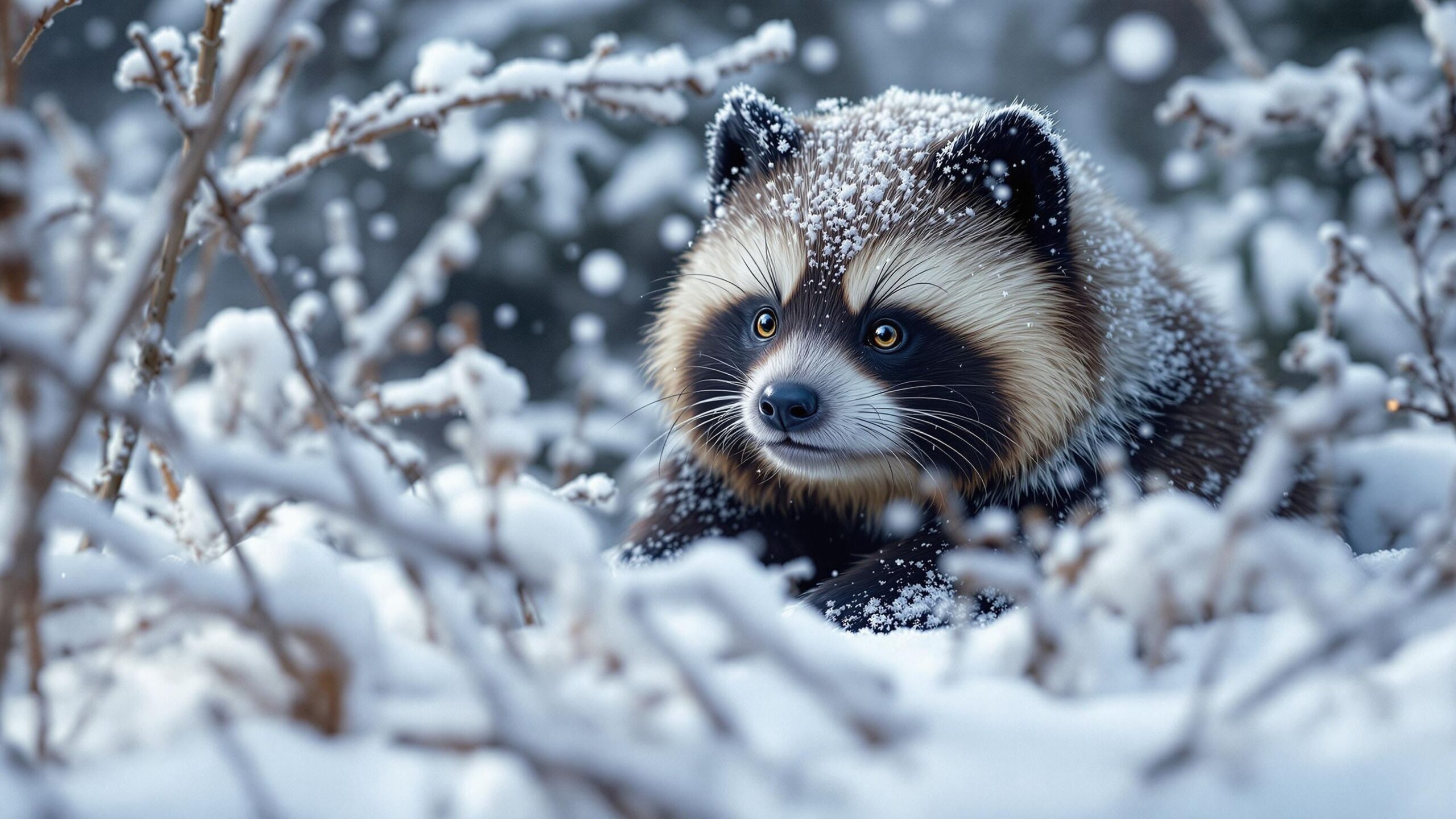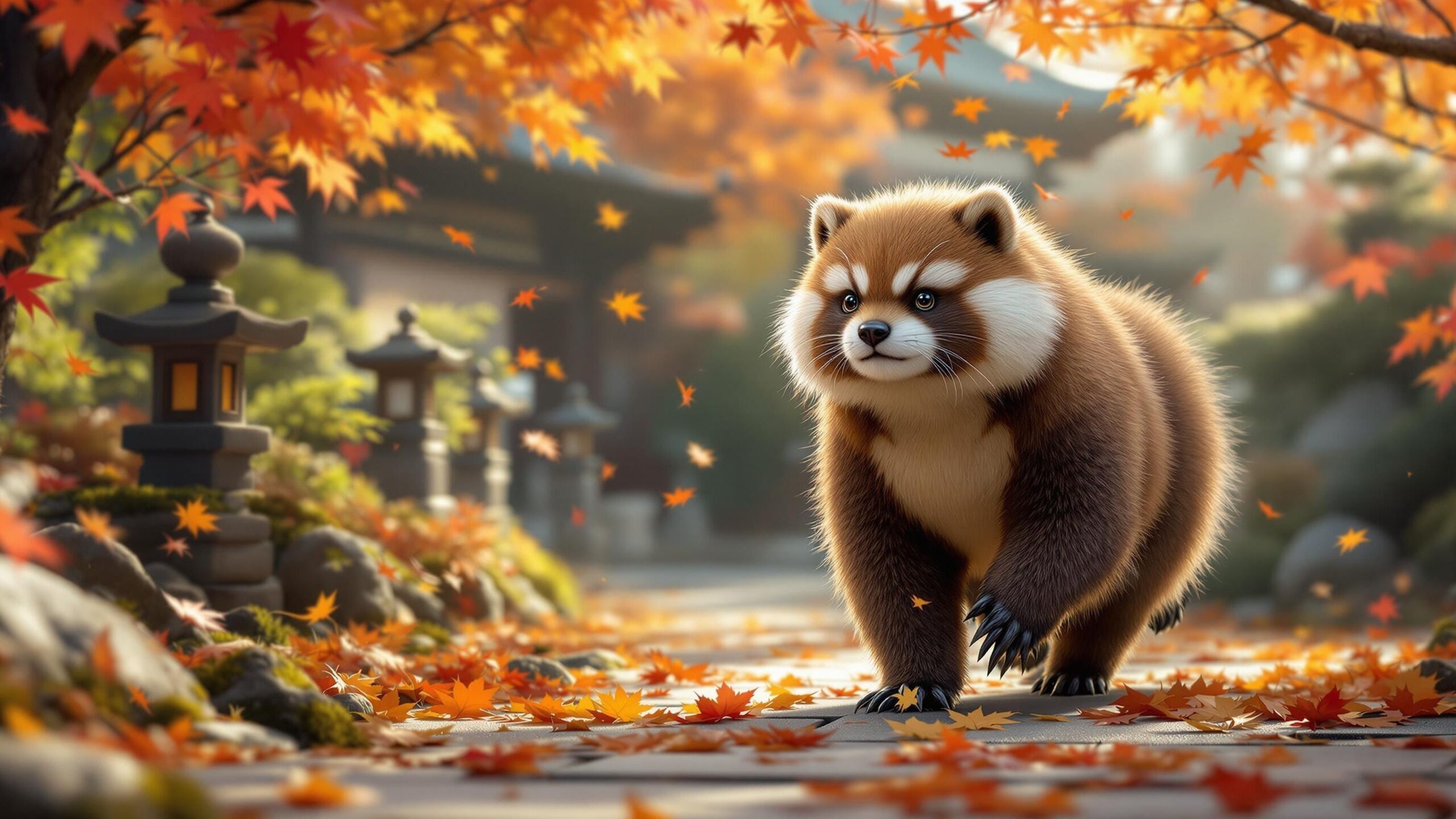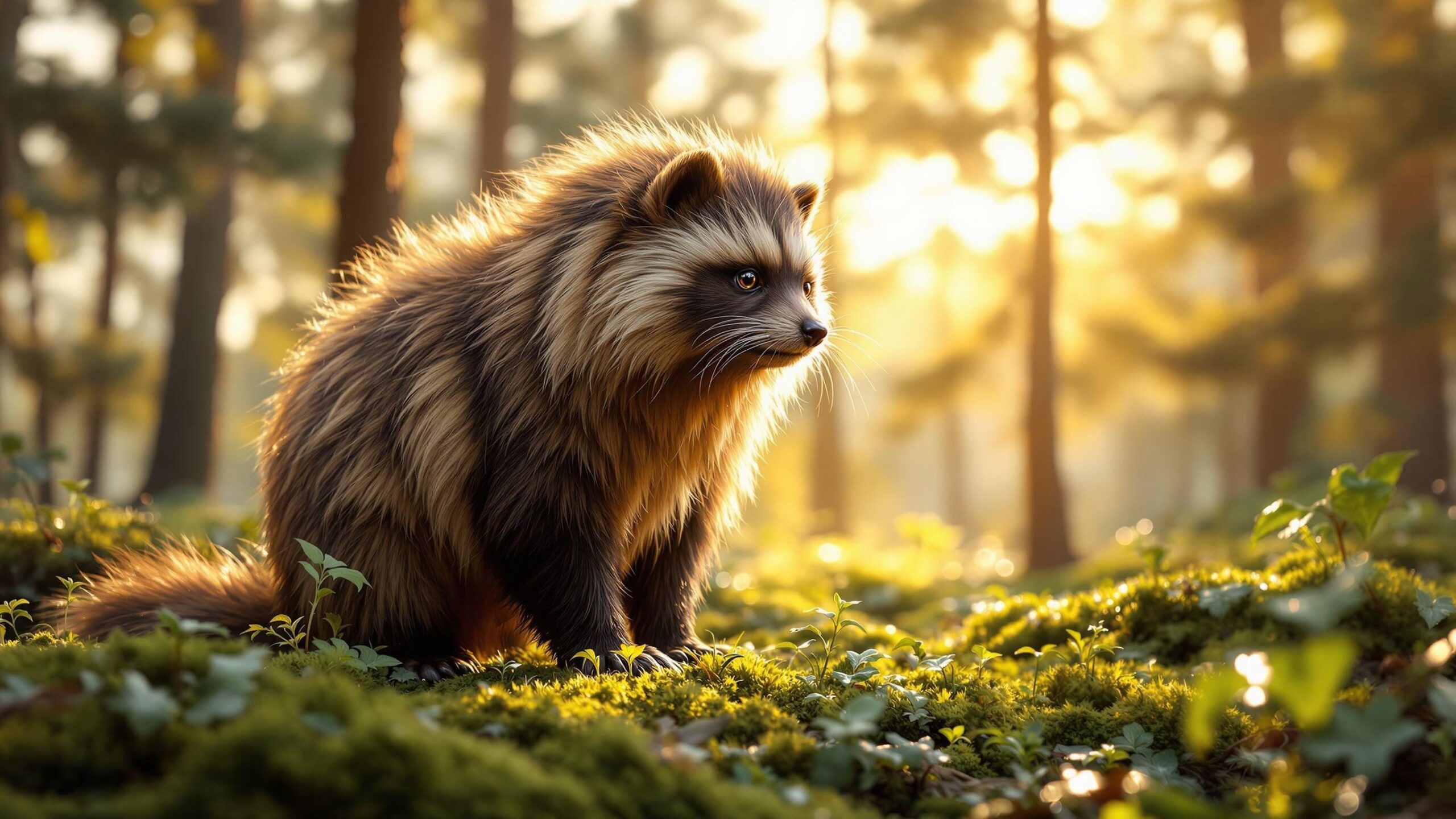Raccoon Dog (Nyctereutes procyonoides): The Masked Mammal of Two Worlds
The raccoon dog, scientifically known as Nyctereutes procyonoides, is one of the most unique and misunderstood mammals in the animal kingdom. With its distinctively masked face, rounded ears, and fluffy fur, this animal often gets mistaken for a raccoon. But despite the resemblance, it’s not a raccoon at all. Instead, it belongs to the Canidae family, making it more closely related to foxes, wolves, and domestic dogs. Native to East Asia but now present in parts of Europe, the raccoon dog occupies a strange and fascinating space in the natural world—part wild dog, part woodland trickster, and entirely its own creature. Let’s delve into the remarkable story of the raccoon dog: from its evolutionary origins and clever behaviors to its misunderstood reputation and ecological impact.
A Foxy Impostor: Identity and Classification
Despite its name and looks, the raccoon dog is not a raccoon. Its appearance is a curious case of convergent evolution—a process where unrelated species independently evolve similar traits. Like the North American raccoon, raccoon dogs sport dark facial markings, bushy fur, and a vaguely mischievous expression. However, Nyctereutes procyonoides belongs to the dog family (Canidae) and is the only extant member of its genus, Nyctereutes. Two main subspecies are commonly recognized: the mainland Asian raccoon dog (N. p. procyonoides) and the Japanese raccoon dog or tanuki (N. p. viverrinus). Although they share many similarities, they differ slightly in size, fur thickness, and behavior. Both, however, share a place in the folklore and landscapes of their native regions.
Origins and Evolution
The evolutionary story of the raccoon dog stretches back millions of years. Fossil evidence suggests that early ancestors of Nyctereutes appeared in Eurasia during the Pliocene Epoch. These primitive canids adapted to forested environments, evolving shorter limbs, a stockier build, and thick fur to suit life among dense vegetation and temperate climates. Unlike most canids, raccoon dogs never developed a strong inclination for speed or pursuit hunting. Instead, they embraced stealth, omnivory, and seasonal behaviors like hibernation-like torpor—traits more common in small mammals than in dogs. These adaptations made them generalists, and as generalists, they thrived.
Range and Distribution: From East Asia to Europe
The raccoon dog’s native range spans eastern China, the Korean Peninsula, and most of Japan, with isolated populations in Russia and Southeast Asia. But it’s the species’ expansion into Europe that has drawn the most attention from conservationists and ecologists. In the mid-20th century, raccoon dogs were introduced into parts of the Soviet Union for fur farming. From there, they dispersed rapidly across much of northern and central Europe. Today, wild populations exist in Finland, Germany, Poland, and the Baltics, and their presence has even been recorded in France and the Netherlands. While this expansion is a testament to the raccoon dog’s adaptability, it has also raised concerns about its ecological impact in regions where it is considered an invasive species.

Habitat Preferences
Raccoon dogs are creatures of the edge—preferring landscapes where forest meets field, or wetland meets thicket. They are often found near rivers, marshes, agricultural land, and lowland forests, where dense vegetation provides cover for resting and nesting. These animals are especially drawn to mixed habitats that offer a buffet of small prey, fruit, and vegetation. In Japan, tanuki can be found surprisingly close to human settlements, even in suburban gardens and temple grounds. In rural areas of Europe, they take advantage of hedgerows, ditches, and meadows, using their agility and camouflage to move undetected.
Physical Characteristics
The raccoon dog is a compact, low-slung canid with a body length of about 50 to 65 centimeters (20 to 26 inches), a tail that adds another 13 to 18 centimeters (5 to 7 inches), and a weight ranging from 4 to 10 kilograms (9 to 22 pounds). Its dense, woolly fur is usually a mottled brown, gray, and black, with a trademark dark facial mask that gives the animal its name. What sets it apart from other wild canids is its short limbs, small head, and rounded ears, giving it a more “cuddly” appearance. This look has made it a favorite in folklore, especially in Japan, where the tanuki is a popular figure in mythology, often portrayed as a mischievous, shape-shifting creature with magical powers and a love for sake.
Behavior and Social Life
Raccoon dogs are primarily nocturnal, spending daylight hours resting in dense underbrush, burrows, or hollow logs. At night, they emerge to forage. Unlike most canids, raccoon dogs are monogamous and typically live in pairs. Mated couples often share a territory, raise young together, and remain loyal throughout the year.
They are also relatively silent animals. While they can bark and growl when threatened, they usually communicate through scent marking, body language, and subtle vocalizations. Their movements are slow and deliberate, and they are adept climbers—capable of ascending low trees to escape predators or search for food. In colder climates, raccoon dogs enter a period of torpor during the winter months. Though not true hibernators, they significantly reduce their activity, relying on stored body fat to survive until spring.
Diet: Omnivorous Opportunists
Raccoon dogs are opportunistic omnivores, eating a wide range of food depending on the season and availability. Their diet includes small mammals, amphibians, birds, eggs, insects, fruits, berries, roots, and even carrion. This dietary flexibility allows them to thrive in diverse habitats and survive harsh conditions.
In agricultural areas, they may consume crops, fallen fruit, or discarded food, occasionally bringing them into conflict with farmers. In more natural settings, they play a role in pest control by preying on rodents and insects, as well as in seed dispersal through the fruits they consume.
Reproduction and Lifespan
Mating season typically occurs in late winter or early spring, with gestation lasting around 60 days. A female raccoon dog gives birth to a litter of 6 to 9 pups, although litters can be larger. Both parents are involved in rearing the young—a rare trait among wild canids. The male often brings food and protects the den, while the female nurses and grooms the pups. Pups are born blind and helpless, but they develop quickly, weaning at around four weeks and becoming independent by autumn. In the wild, raccoon dogs live an average of 3 to 5 years, although individuals in captivity can live up to 10 years.
A Creature of Myth and Culture
In Japanese folklore, the tanuki is a beloved mythical creature, often depicted with exaggerated features and magical abilities. These whimsical versions of the raccoon dog appear in legends, statues, art, and even video games. They are said to be shapeshifters, pranksters, and bringers of fortune—sometimes wise, sometimes foolish, but always entertaining. While the mythical tanuki bears little resemblance to its real-life counterpart in behavior, the cultural fascination with raccoon dogs speaks to their lasting impression on human imagination.
Ecological Role and Environmental Impact
In their native habitats, raccoon dogs play a modest yet meaningful role in maintaining ecological balance. As both predators and scavengers, they help control small animal populations and clean up carrion. As fruit-eaters, they contribute to seed dispersal. However, in areas where they have been introduced—particularly in parts of Europe—raccoon dogs have raised ecological red flags. Their predation on ground-nesting birds, amphibians, and native small mammals can disrupt local ecosystems. In some cases, they compete with native carnivores like red foxes or badgers. Still, their long-term ecological impact is subject to ongoing study. Some researchers argue that their adaptability and generalist nature allow them to fill unoccupied ecological niches, while others advocate for more active management or population control.

Threats and Conservation Status
Despite their success in spreading to new regions, raccoon dogs face threats in both their native and introduced ranges. Habitat destruction, road mortality, disease, and fur trapping are among the most common dangers. In some countries, they are actively culled as invasive species, further complicating conservation efforts.
Globally, the raccoon dog is currently listed as “Least Concern” on the IUCN Red List due to its wide distribution and relatively stable population numbers. However, regional threats can still pose significant challenges. In Japan, for instance, some local populations have declined due to urban development and competition with invasive species like raccoons and feral cats. In parts of Europe, they are monitored closely due to their non-native status. While some countries tolerate or even accept their presence, others consider them a nuisance requiring regulation.
Fur Trade and Ethical Considerations
The raccoon dog is one of the most commonly farmed animals for fur, particularly in China. Known in the industry as “Asiatic raccoon” or simply “tanuki,” its soft, dense fur is used in everything from fashion garments to trim on parkas and hats. This fur trade has sparked significant controversy, especially regarding animal welfare conditions and the ethics of fur farming.
Animal rights organizations have documented poor treatment on some fur farms, leading to calls for stricter regulations or outright bans on raccoon dog fur products. As consumer awareness grows, the future of this trade remains uncertain. Some countries have already enacted bans or labeling laws to inform consumers about the origin of fur garments.
Raccoon Dogs in Urban Life
Raccoon dogs are surprisingly adaptable to urban and suburban environments. In parts of Japan and eastern Russia, they’ve been observed roaming city parks, quiet streets, and green corridors at night. Their nocturnal habits and cautious movements allow them to coexist near humans with minimal disturbance.
In urban areas, they may feed on trash, pet food left outdoors, or natural food sources like insects and fallen fruit. While they rarely pose a direct threat to people, conflicts can arise when they are seen as pests or become roadkill hazards. Public education campaigns in some regions encourage residents to avoid feeding raccoon dogs and to secure garbage bins, minimizing encounters and promoting safer urban coexistence.
A Creature of Complexity
The raccoon dog defies easy classification. It looks like a raccoon, acts like a fox, and belongs to the dog family—yet it fits none of those roles perfectly. It is both revered in folklore and reviled in invasive species debates. It is wild and elusive, yet oddly familiar.
As we continue to explore and understand the natural world, the raccoon dog serves as a reminder that nature rarely conforms to our expectations. Whether navigating Japanese temples or European fields, this quiet wanderer continues to thrive by being flexible, resourceful, and entirely itself. Understanding and respecting animals like the raccoon dog helps broaden our appreciation of biodiversity, adaptiveness, and the subtle roles each species plays in the complex web of life.

